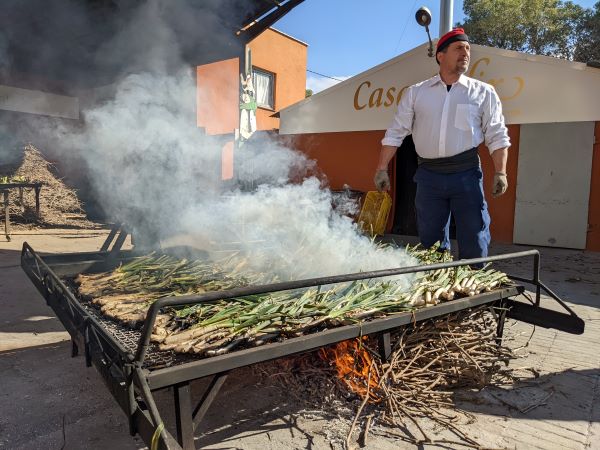Calçot onions, the quintessential Catalan delicacy
Barbecued scallion-like veggies are enjoyed at calçotades from January to March

Catalonia is famed for its cuisine. But in the earliest months of the year, one particular food rises above the rest to become a centerpiece of Catalan culture - calçots.
Legend has it that calçots, which could be described as a cross between a leek and a spring onion, were discovered by a peasant by the name of Xat de Benaiges at the end of the 19th century in the small town of Valls, just north of Tarragona.
"A calçot is a special type of white onion that is cultivated in a way that makes it grow in a long form and not rounded like a regular onion," says Laura Ricote of Casa Fèlix, one of the finest calçot restaurants in Valls. "It has to be eaten with a special sauce and it's grilled with a fire flame."
At Casa Fèlix, around 500 of the long onions can be cooked at a time over a fire of burning vine shoots, which provide the perfect flavor and flame duration.
These vegetables are grown across the territory, but Valls is undoubtedly the calçot capital of Catalonia with its own Protected Geographical Indications status. The Calçot de Valls must have a white stalk that is 15 to 25 cm long and a diameter measured 5 cm from the root between 1.7 and 2.5 cm.
"Valls is special because the origin of calçots is here in our home town," says David Nieto, who also works at Casa Fèlix. "The fields and the climate are perfect to cultivate the calçot."
Why are they called calçots?
"The name 'calçots' comes from the word 'calçar,' and 'calçar' means when we plant the leaf and it starts to grow, we cover it to make it grow in a long form," Ricote explains. In English, this technique is known as hilling.
The word also means 'to wear on one's foot' or 'to shoe' and it comes from the Latin term 'calceus' for a type of boot worn in ancient Rome.
Calçotades: how to eat calçots
Calçots can get messy! They are eaten in a specific way, by holding the green leaves in the center and peeling off the sooty outermost layer. Dip them in the orange 'salvitxada' sauce, and lower them into your mouth from above. Bibs, called 'pitets', are usually provided in restaurants and sometimes gloves are too, but you should still expect to get dirty.
One of the most important aspects of calçots is the ritual of eating them. These barbecued onions served on terracotta tiles are not commonly eaten at home, but more so as the centerpiece of events known as calçotades, popular social gatherings with friends and family that usually take place from January to March.
"To talk about a calçotada is to talk about meetings, talk about family, friends," says Nieto. "Traditionally people met up with each other to enjoy a calçotada and spend a good time together."
Each year, Valls hosts the 'Gran Festa de la Calçotada', a huge calçot festival, complete with competitions for calçot growers, sauce makers, and of course an eating contest. Adrià Wegrzyn, from Barcelona, is the undisputed calçot king, winning the competition more times than anybody else, and setting the record in 2018 with almost 6 kilograms of the vegetable eaten.
The calçot business
Around 15 million of the onions were sold in 2019, and that's only counting those with the Protected Geographical Indications status. Estimations place the total number including all other producers up to four times this figure before the pandemic hit. These figures dipped in 2020 and 2021, but some 17 million could be sold in 2022.
A staple in Catalonia, demand has also been growing across Spain, and calçots can sometimes be found in restaurants in Madrid, Aragon or the Balearic Islands.
In recent years, exports to places like France, Belgium, and Germany have been growing too, so either in Catalonia or elsewhere, you too will be able to enjoy a calçotada.